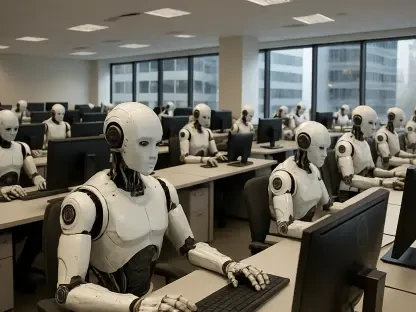In a world where technology is evolving at breakneck speed, the integration of automation into various industries is becoming increasingly unavoidable. The manufacturing sector harnesses robotics to streamline production, finance utilizes algorithms for rapid data processing, and customer service employs AI chatbots for twenty-four-hour query resolution. Yet, as automation becomes more prevalent, companies face the pivotal challenge of maintaining a vital human touch to ensure effective communication, creativity, and emotional intelligence—qualities machines cannot fully replicate. This article examines the current balance of automation and human interaction across industries, explores real-world applications, seeks expert opinions, and anticipates future developments and challenges in this evolving landscape.
Current Landscape of Automation and Human Interaction
Insights into Growth Trends and Statistics
Recent data highlights rapid automation across sectors, revealing its impactful presence. The Global Automation Report estimates that industries witnessed a 38% increase in automation utilization over the last three years. Notably, in retail, automated checkout systems and AI-driven inventory management are reshaping consumer interactions. The healthcare sector shows similar trends, with 42% of processes now automated, from scheduling appointments to diagnosing ailments through machine learning. Such statistics underscore the pervasive nature of technology adoption, emphasizing the need to maintain a strategic balance between automated systems and human involvement.
Real-World Applications and Case Studies
Real-world examples offer compelling insights into how industries successfully blend automation with human inputs. Aerotek’s Job Seeker Survey emphasizes the hiring process, where 72% of candidates seek personal interaction despite technological efficiencies. Such data suggests a hybrid approach, retaining human involvement during critical recruitment phases. Similarly, companies like Allianz and H&M are integrating AI with customer feedback to improve experiences, utilizing human analysts to interpret and modify algorithmic recommendations. By implementing technologies that complement human judgment, businesses enhance operational efficiency while maintaining personalized connections and ensuring a meaningful customer journey.
Expert Perspectives on Technology and Human Touch Balance
Insights from industry leaders reveal the necessity and complexity of maintaining human interaction amidst advanced technologies. Leaders at Amazon stress the importance of human oversight in AI practices to prevent automated decision-making from overshadowing individual judgment. They identify potential risks in evolving workforce dynamics, suggesting retraining programs to equip employees with digital literacy, benefiting both staff and technology integration. Experts from Salesforce share observations on customer relationships, underscoring the unique emotional connections that humans bring to brand experiences, an irreplaceable aspect of service-driven industries. These opinions contribute to understanding the importance of a balanced approach in contemporary and future technological landscapes.
Anticipated Developments and Challenges
The future promises significant advancements as industries further integrate automation with human interaction. Artificial intelligence continues to enhance efficiency and insight generation, potentially shaping environments that boost productivity and customer satisfaction. Imagined developments include AI-powered personalized experiences and predictive analytics, optimizing decision-making processes. However, challenges remain prominent, such as job displacement risks and ethical dilemmas related to privacy and accountability. Addressing these through proper regulatory frameworks and fostering transparent interactions can mitigate potential pitfalls, establishing automation as an aid rather than a substitute for human capabilities.
Reflection on Balancing Human Interaction and Automation
Throughout the analysis, the discourse on balancing human interaction with automation has shown profound implications for sustainable growth and enriching human endeavors. Although automation contributes substantially to efficiency, it cannot replace the emotional depth and creative insight humans bring to the table. This nuanced equilibrium calls for adaptability, ensuring that both aspects enhance rather than overshadow one another. Exploring the integration avenues refines experiences, solidifying trust and fostering deeper connections between businesses and individuals, a feat achievable by valuing and nurturing the human element consistently amid technological progress.









